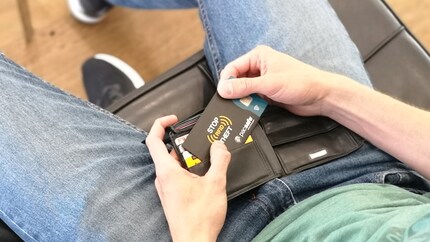
Background information
Who will win the fight for our data?
by Patrick Bardelli

Contactless payment, identity checks and keyless entry to commercial premises are all possible thanks to RFID technology. However, this freedom also comes with risks. Find out here how to protect yourself!
I'm not the only one who's paranoid, impossible. Every time I remove my bankcard from the payment terminal at a shop checkout, I have to justify why contactless payment is disabled. No, dear cashier, my card is not faulty. I like to play it safe and therefore accept that my transactions take a few seconds longer than others.
Contrary to me, more and more people are shopping without entering a PIN code. According to a study by Comparis, this already accounts for one in two Swiss people. And the trend is rising. Many don't realise that contactless payment carries two risks: if your card is lost, the thief can either withdraw several amounts of less than CHF 40 in a row, or read your personal data with a device without stealing your wallet.

All RFID systems are based on a reader and a transponder, an electronic data storage device. When a reader is approached, an exchange of information takes place. To this end, the two devices are equipped with coupling elements in the form of antennae. Data is exchanged using electromagnetic waves, which form the transport system for the information to be exchanged. In the case of a bank card, for example, this technology is found in a microchip and an antenna directly on the card. When a payment is made, all the information relating to the transaction is transmitted to the payment terminal reader without inserting the card and without entering a PIN code, in other words without contact.
A hacker who gets too close to you could steal your bankcard data with a reader. Under what circumstances does he approach you unnoticed? At a concert, on a crowded bus, in a nightclub, in a queue at a ticket office, for example. The only challenge for a digital pickpocket is to get close enough to his victim's wallet with a reading device, such as a mobile phone equipped with special software. He will then be able to use the data entered for online purchases, as long as the three- or four-digit cryptogram is not required.
To protect yourself from possible data theft, there are special passport and payment card covers. They block radio waves, preventing the transmission of your personal data and protecting you against theft. By the way, did you know that there are RFID wallets? [[product:6281144,10093882,6281143]]
Find all the RFID wallets and dedicated accessories
When I’m not exploring the depths of the sea as an open water diver, I enjoy plunging into the world of fashion. On the streets of Paris, Milan and New York is where I keep my eyes peeled for the latest trends. And I’ll show you how to take them from the catwalk to your everyday life.
Interesting facts about products, behind-the-scenes looks at manufacturers and deep-dives on interesting people.
Show all